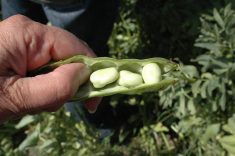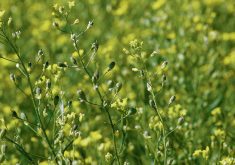While some areas of Alberta struggled with a lack of precipitation and heat, pulse growers are faring much better overall than in drought-stricken 2021.
But there’s been no turnaround when it comes to transportation woes.
“We already know (there’s) going to be greater production this year, thanks to some timely rains we had earlier in the season,” Alberta Pulse Growers executive director Leanne Fischbuch said late last month.
Read Also

Moo translator and methane measures: There’s an app for that
Dalhousie University researchers use artificial intelligence to create new dairy farm apps that analyze cattle sounds and measure methane.
“Hearing from directors across the province, the peas look very good coming into harvest. But obviously, whatever types of weather we’re getting over the next couple of weeks will really decide the crop quality in the end.”
Production fell off a cliff last year. Alberta growers harvested less than 900,000 tonnes of peas (half of what they grew in 2020) while lentil production dropped by 55 per cent even though seeded acreage rose by 20 per cent, according to Statistics Canada.
[READ MORE] Pulse weekly outlook: Australia’s winter pulse production mixed
Weather is the top concern right now but Fischbuch said producers are also hoping Canada’s grain transportation system will come through once the crop is harvested and ready for sale.
The twin problems of scarce shipping containers coupled with poor service from shipping lines — both pandemic related — haven’t been solved, said Greg Northey, vice-president of corporate affairs with Pulse Canada.
“We’ve been having a lot of issues with containers — there hasn’t really been a real resolution with them,” he said. “They are still two to three times more expensive than they would have been pre-pandemic. The service and capacity available for export movement is still much lower than it was pre-pandemic as well.”
The problems started when house-bound consumers went on a shopping spree early in the pandemic. That led to a scramble for shipping containers and made it more profitable to ship them back to Asia empty instead of loading them with North American goods and commodities, including peas and lentils.
And while consumer demand has slowed considerably in the last few months, the congestion at ports hasn’t cleared.
“A lot of imports are staying around port and clogging up ports,” said Northey. “There are a lot of export containers that are empty and not being rushed back to Asia the way they were. (But) there’s still a reticence by shipping lines to make capacity available for export of agriculture products to various destinations.”
Pulse Canada has teamed up with the Western Grain Elevator Association on a PR campaign called “Canada’s Ready.” Because of the war in Ukraine and fears of global food shortages, the campaign’s theme says this is “the most important harvest in a generation” so railways and ports must show they are ready to handle grain exports.
It is now easier to get shipping containers but getting through a port is a problem, said Northey, adding the situation in Montreal is the worst right now. But the overall situation is poor because shippers are using their leverage as the middle men to constrain supply and keep profit margins high, he said.
“It’s not a reliable system, it’s not an efficient system,” said Northey. “Nothing is smooth about it. Pretty much every exporter moving the crops (is) working constantly to try and scrape together some service. A lot of them have invested heavily in warehousing.”
Meanwhile, the expectation of a decent harvest has pulse buyers calling and “there seems to be pretty robust demand,” he said.















